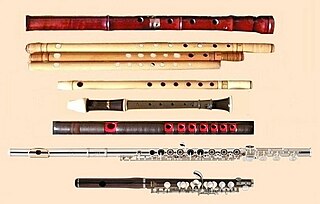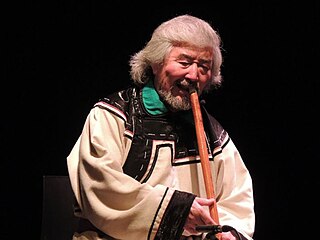
The flute is a member of a family of musical instruments in the woodwind group. Like all woodwinds, flutes are aerophones, producing sound with a vibrating column of air. Flutes produce sound when the player's air flows across an opening. In the Hornbostel–Sachs classification system, flutes are edge-blown aerophones. A musician who plays the flute is called a flautist or flutist.

An aerophone is a musical instrument that produces sound primarily by causing a body of air to vibrate, without the use of strings or membranes, and without the vibration of the instrument itself adding considerably to the sound.
The gusle or lahuta is a bowed single-stringed musical instrument traditionally used in the Dinarides region of Southeastern Europe. The instrument is always accompanied by singing; musical folklore, specifically epic poetry. The gusle player holds the instrument vertically between the knees, with the left hand fingers on the string. The string is never pressed to the neck, giving a harmonic and unique sound.

An aulos or tibia (Latin) was a wind instrument in ancient Greece, often depicted in art and also attested by archaeology.

A bansuri is an ancient side-blown bamboo flute originating from Indian Subcontinent. It is an aerophone produced from bamboo and metal like material used in many Indian and Nepali Lok songs. A bansuri is traditionally made from a single hollow shaft of bamboo with seven finger holes. Some modern designs come in ivory, fiberglass and various metals. The six hole instrument covers two and a half octaves of music. The bansuri is typically between 30 and 75 centimetres in length, and the thickness of a human thumb. One end is closed, and few centimeters from the closed end is its blow hole. Longer bansuris feature deeper tones and lower pitches. The traditional design features no mechanical keys, and the musician creates the notes they want by covering and uncovering the various finger holes.

The kaval is a chromatic end-blown oblique flute traditionally played throughout the Balkans and Anatolia. The kaval is primarily associated with mountain shepherds.

The zurna is a double reed wind instrument played in Central Asia, West Asia, the Caucasus, Southeast Europe and parts of North Africa. It is also used in Sri Lanka. It is usually accompanied by a davul in Armenian, Anatolian and Assyrian folk music.

The suling is a musical instrument of the Sundanese people in Indonesia. It is used in the Degung ensemble. Bamboo ring flute can also be found in Southeast Asian, especially in Brunei, Indonesia, Malaysia, the Philippines and Singapore.

The duduk or tsiranapogh, is a double reed woodwind instrument made of apricot wood originating from Armenia. Variations of the Armenian duduk appear throughout the Caucasus, the Balkans, and the Middle East, including Bulgaria, Azerbaijan, Georgia, Kurdistan, Turkey, and Iran. Duduk, Balaban, and Mey are almost identical, except for historical and geographical differences.

Diple, also known as misnjiče, miješnice and mih, is a traditional woodwind musical instrument originating in the Adriatic Littoral. It is played in Bosnia and Herzegovina, Croatia, Slovenia, Montenegro, and Serbia.
The guan is a Chinese double reed wind instrument. The northern Chinese version is called guanzi or bili and the Cantonese version is called houguan. It is classified as a bamboo instrument in the Ba Yin system. Unlike other instruments in the double-reed family of woodwinds which mostly have conical bores, such as the Chinese suona or the Western oboe, the guan has a cylindrical bore, giving its distinctive mellow, yet piercing buzz-like timbre.
The shvi is an Armenian fipple flute with a labium mouth piece. Commonly made of wood or bamboo and up to 18 inches (460 mm) in length, it typically has a range of an octave and a-half. The tav shvi is made from apricot wood, it is up to 18 inches (460 mm) long, and is tuned 1/4 lower producing a more lyrical and intimate sound.
The mey is a double-reed aerophone used in Turkish folk music. The mey, duduk, and balaban are almost identical, except for historical and geographical differences.
Hujia is a traditional Mongolian double reed instrument traditionally used to accompany khoomei. The Eighteen Songs of a Nomad Flute was adapted from Hujia song in Han dynasty.

The Bulgarian dvoyanka is a double flute made of a single piece of wood, with six sound holes on one side.

Slobodan Trkulja is a Serbian multi-instrumentalist, composer and singer in traditional and Byzantium style. Trkulja is one of the first artists who composed, performed, and popularized Balkan Traditional Music with a modern approach in arrangements. He is the founder of the Modern Balkan Tradition music genre, although he is most famous for his collaboration with Metropole Orchestra from Netherlands in 2008. Aside from playing 13 instruments, Dutch daily NRC Handelsblad called him "one of the most beautiful male voices of the Balkan." He had no formal music training until 1997, but attended a public high school in Sremski Karlovci. Slobodan moved to Netherlands in 1997, and returned to Serbia in 2008, where he has been since.

The tsuur, choor (Kyrgyz), or chuur is an end-blown flute of varying lengths that is common among Inner Asian pastoralists.
Lamzdeliai (pipes) are traditional wind instruments in Lithuania. The instrument was popular during night herding, at young people's gatherings, and weddings. Lamzdeliai are used to play improvised herding melodies—raliavimai, ridovimai, and tirliavimai. Herders calmed their animals with these melodies, or they imitated the sounds of nature and birds. Other tunes played on the pipes were sutartines, songs, and contemporary dances.
The fyell brezi, also known as fyell shoke or fyell bariu is an aerophone end-blown instrument traditionally played throughout Albania and other Albanian inhabited lands. The instrument is commonly associated with shepherds of the Albanian highlands, commonly referred to as the Dukagjin highlands.











